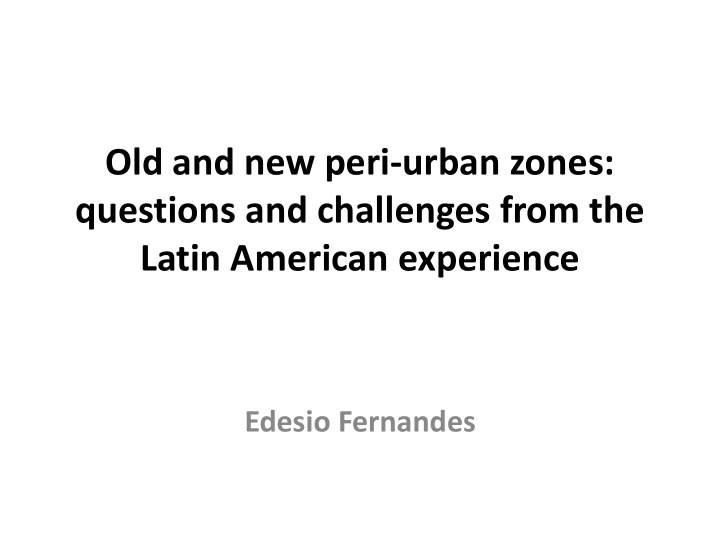



Old and new peri-urban zones: questions and challenges from the Latin American experience Edesio Fernandes
The LA urbanisation: two movements, similar model • Older peri-urban zones • More recent peri-urban zones • Dynamic areas and communities, but unsustainable development model • Land governance crisis
Older peri-urban zones • Urbanization long consolidated: 80% (Brazil 84%) • Metropolitanization (primary and others) • Pattern of sociospatial segregation • Huge housing deficit + serviced vacant land + empty/under-utilised private and public properties • Concentration of infrastructure, services and equipment • Backlog of urban-environmental problems: sanitation, transportation and mobility, urban security
Urban development as informal development • Structural informality: rule, not exception • Peripheral informal settlements (unlike US suburbs) and sometimes also central (favelas) • More and better opportunities of access to land and housing than public policies and official markets combined • Dynamic areas and communities, but insecure tenure and high socioenvironmental, political and economic costs
The post-industrial LA city • Increasing commodification; capitalist production in the city and of the city • Growth of construction sector • Growing penetration of national and global land and property capital • Record-breaking land/property/rental values in formal and informal markets alike; speculation • Old centers losing population • Further peripherization of the poor (even favelas) • Peripheral gated communities: rich and poor dispute space
The eviction game is back • Eviction by landowners • Eviction by public authorities – large-scale projects, infrastructure, sports events, urban renewal • Eviction by the market – gentrification, regularization programs, infrastructure, services and equipment, governmental subsidies
More recent developments: the new peri-urban zones • Declining urban growth rates, though still high • Changes in migration pattern: growth of middle-sized and small cities • The new frontier: the Amazon • New system of cities with different logic • Expansion of new peri-urban zones
Migrants’ New Paths Reshaping Latin America • Many Mexican migrants now shun the border for Mexican towns like Santa María Atzompa. http://www.nytimes.com/2012/01/06/world /americas/migrants-new-paths-reshaping- latin-america.html?_r=1
Main causes • Economic, sociopolitical and cultural rural-urban, urban-urban, national and international migration • Changes in agricultural production • Search for mineral resources • Better infrastructure • Information technology (youth) • Industrial relocation strategies • Displacement by conflict • High land prices • Money laundering…
Growing disputes over use of land • Water reservoirs • Vegetation and green belts • Food production (encroaching of farming land) • Impact of infrastructure projects (airports) • National and international public, communal and private land grabbing • Acquisition of coastal land • Unlicensed industrial activities • Costs of transportation and mobility • Environmental impact – man-induced disasters
New informal development processes • Significantly, if not largely, informal • Poverty does not explain it all • Rates higher than urban and poverty growth • Lack of functioning land supply mechanisms • Lack of adequate land administration and demarcated central areas for social housing • Lack of adequate public housing policies • Lack of options by formal developers
The new peri-urban zones • For all their dynamism, unsustainable model • So much for the aspiration of compact cities • Take a leaf out of Solly Angel’s book Making Room for a Planet of Cities • While trying to contain/divert process, anticipate urban expansion and prepare for it
Peri-urban zones: no one’s land • No legal-technical treatment of urban expansion • Manipulated perimeters to generate tax revenue • No territorial control or licensing of activities • Lack of local administrative capacity to act • Authority conflicts and interference from higher governmental levels • Governance voids and representation failure • Legal grey areas and corruption • Need for integrated land governance legal framework
A land framework • Democratize access to serviced land and housing and provide security of tenure • Articulated territorial order: preventive and remedial land, urban, housing, environmental, fiscal policies in light of inclusive socioeconomic and socioenvironmental development; social function of private and public property • Rural – “rurban” – policy • Urban planning revival – different bases, not merely regulatory, but inducing land market movements • Learn from dynamic informal markets
A governance framework • Local capacity building • Intergovernmental articulation • Metropolitan apparatus and regional scope • Involvement of private and community sectors in land management • Popular participation in decision- and law- making • Financing urban development: traditional taxation and other forms of surplus land value capture
The challenge of a new social contract • Peri-urban zones require a new sociopolitical pact to recognize positive dimensions and minimize negative ones, promote sociospatial inclusion and fairer distribution of costs and benefits of urban development • The Right to the City
Recommend
More recommend